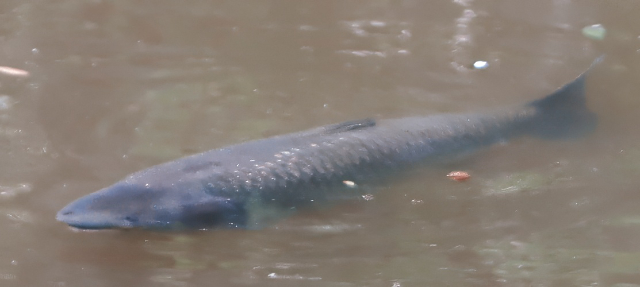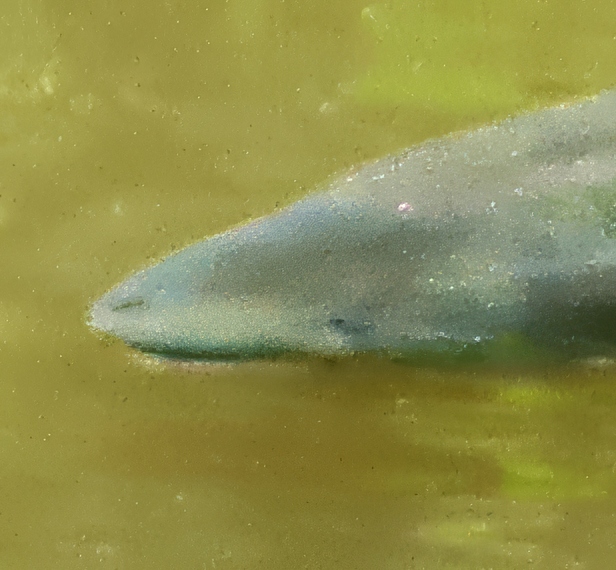I ended this post with a teaser about a fish. Here’s why I was being so koi…I mean, coy.
A week or so ago, I was standing on the creek bank across from our house when I spotted a strange ripple moving slowly in the water. At first, I thought it was a snake but as it got closer I could see that it was a fish — a very long fish, compared to the normal inhabitants of the creek — swimming near the surface of the water. Fortunately, I had my camera with me and I was able to take some photos.

I applied quite a bit of post-processing to the photos in an attempt to get a more detailed look at the fish.


It was at least two feet in length, and the mouth and head are unlike any freshwater fish I’ve ever seen, although the rest of the body was nothing out of the ordinary. I posted the preceding two photos on Facebook and asked for an identification from anyone more knowledgeable than me about fish…which is pretty much everyone.
The general consensus was that it’s a carp, and more specifically a grass carp (Ctenopharyngodon idella) or a black carp (Mylopharyngodon piceus). Both of these species are classified as non-native or invasive, and generally deemed to be unwelcome and destructive residents, although the story of the grass carp is a bit more complicated than that.
Grass carp were imported by the US Fish and Wildlife Service from Asia more than fifty years ago in an experimental attempt at controlling aquatic weeds, as they are voracious herbivores. According to this fact sheet [PDF] from the Texas Parks & Wildlife Department, the preferred foods are bushy and American pondweeds and hydrilla; they aren’t effective in controlling milfoil.
As with almost every attempt to use nature to fight nature, unintended consequences occurred when the fish escaped from the aquaculture facilities where they were housed, and they eventually spread to every state in the country except Alaska (see this map and list of “non-indigenous occurrences” which is maintained by the USGS). And because they have such a strong appetite for aquatic weeds, they started decimating the ecologies of various bodies of water by reducing the food supply of native aquatic herbivores.
Now, just because grass carp have the potential for damaging aquatic ecology, that doesn’t mean they can’t serve a useful purpose if properly controlled. That control means introducing them in limited numbers and ensuring that they can’t reproduce. This is achieved by introducing triploid carp — fish with three sets of chromosomes, rendering them infertile. The mechanism(s) for creating these infertile carp can’t be covered in this post, but feel free to read this article if you want to know more.
Why is any of this relevant to the subject at hand? It is possible that the grass carp in our creek is, in fact, a triploid specimen, meaning that its impact on the microenvironment will be minimal, and could actually be positive. Our slow-moving creek does have an increasing infestation of aquatic weeds, and a bit of thinning would be a good thing. The problem is that I don’t know how to find out if that’s the case.
It’s not that I didn’t trust my Facebook friends, but since there was some conflicting suggestions, I posted the photos to my iNaturalist account and requested confirmation of the proposed grass carp identification. Within a few hours I had three confirmations of Ctenopharyngodon idella, which merited my observation a “Research Grade” classification.
iNaturalist also flagged my observation as the only one reported to-date in Llano County. FWIW, that’s consistent with this list maintained by the Texas Parks & Wildlife Department (“TPWD”) showing public waters in Texas for which the release of triploid grass carp has been approved and permitted. (For my friends living in Midland, you’ll note that Hogan Golf course is on the list.) Permits have been issued in San Saba and Lampasas counties, north of us, and in Travis county to our southeast.
Of course, it’s possible and even likely that grass carp appear in non-permitted areas. But the watershed for Pecan Creek originates in the middle of nowhere in neighboring Blanco county and covers a relatively small area with no feeds from any major waterways. And our specific location is a couple of miles upstream from where the creek feeds into Lake LBJ. It would be unlikely that a fish could make it from the lake into our section of the creek. Bottom line: how it got here is a mystery. I’ve emailed a report and the photos to the TPWD in case it wants to investigate further and I received a very prompt response saying that they would at least make a note of the sighting. And, furthermore…
As this water body was not intentionally stocked with grass carp for vegetation management, you can keep/dispatch/dispose of the grass carp if caught.
As I’m not an angler so the only way I’ll capture it is with a camera; I’ll leave the physical capture to the neighborhood fisherpeople.
Update: I was looking over the creek when I spotted a familiar ripple in the water. Here’s a short video of terrible quality (iPhone zoomed in too far) that shows the fish apparently feeding on something.
Discover more from The Fire Ant Gazette
Subscribe to get the latest posts sent to your email.

